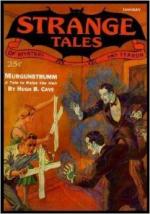|
This section contains 336 words (approx. 2 pages at 300 words per page) |

|
Derleth uses sophisticated layers of narrative to create simultaneous impressions of immediate personal danger and coolly detached observation, and these qualities largely provide the sense of verisimilitude that is essential to the story's success. The use of a frame narrator is common in fiction; often, as in "The Thing That Walked on the Wind," the frame narrator is someone who can fill the gaps in a story after the main narrator—in this case Norris—has perished. Dalhousie provides the narrative perspective of the hard-nosed professional police officer who has discovered what caused the death of one of the men in his command. Derleth takes this basic frame structure and extends it. Dalhousie's narration also serves as a frame for the account by Peter Herrick, whose observations are essential to establishing the veracity of Norris's report. Norris himself becomes a frame narrator who offers...
|
This section contains 336 words (approx. 2 pages at 300 words per page) |

|




